Credit Finance Sub-Group and NPRR Updates
Updates from the Credit Finance Sub-Group include discussions on operational NPRRs, new invoice reports, EAL changes, and DC Energy's exposure calculations. The group considered improvements in credit implications, concentration limits, and more. NPRR 1186 was reviewed for enhancements to ESR monitoring. Additionally, a mock-up of a new daily invoice report was favored for implementation. DC Energy aims to align exposure calculations with actual risks for market participants. Further adjustments to collateralization and timing are being explored to refine base exposure calculations.
Download Presentation

Please find below an Image/Link to download the presentation.
The content on the website is provided AS IS for your information and personal use only. It may not be sold, licensed, or shared on other websites without obtaining consent from the author. Download presentation by click this link. If you encounter any issues during the download, it is possible that the publisher has removed the file from their server.
E N D
Presentation Transcript
Credit Finance Sub Group update to the Technical Advisory Committee Brenden Sager, Austin Energy, Chair Loretto Martin, NRG, Vice Chair 22 August 2023 1
General Update General Update 16 Aug CFSG meeting Voting matters Operational NPRR s without credit impacts Discussion items New invoice report EAL change proposals and analysis DC tie double counting in credit calcs Letter of Credit Concentration Limits NPRR 1112 Regular credit exposure updates
NPRR Reviewed NPRR Reviewed 1186NPRR Improvements Prior to the RTC+B Project for Better ESR State of Charge Awareness, Accounting, and Monitoring CFSG voted to consider operational without credit implications
Mock up of new invoice report Mock up of new invoice report Proposed new daily report includes previous day s posted invoices for all activities Group discussion favors implementation Will file an SCR or NPRR 4
EAL Changes and Analysis // DC Energy EAL Changes and Analysis // DC Energy DC Energy's desire is to align the exposure calculations to better reflect the actual risk of a market participant's activity Reduce over/under-collateralization Align the Forward Adjustment Factors (FAFs) with the base exposure calculation FAFs are intended to account for forward price movements that are not captured in the base exposure calculation and timing mismatches in formula DC believes the correct way is to take the base exposure calculation and the FAF together since they are interdependent 5
DC Energys EAL Changes, contd DC Energy s EAL Changes, cont d In order to reflect actual risk, the calculated exposure for the day-ahead and real-time need to be taken together so they are based on the same days and weighting factors Today RT and DA components of extrapolated and unbilled liability are treated independently, which does not reflect the real risk This calculation would make other components of the credit algorithm less complex Pause certain credit exposure parameters for Market Participants that stop trading The current look-back nature of the exposure calculations do not recognize a market participant who willingly stops trading during high-risk periods The trigger to identify when a QSE stops market activity could be programmatic as is the case for the Protocol Section 4.4.10 e-factors
EAL Changes // ERCOT Presentation EAL Changes // ERCOT Presentation EAL q = Max [IEL during the first 40-day period only beginning on the date that the Counter-Party commences activity in ERCOT markets, RFAF * Max {RTLE during the previous lrq days}, RTLF] + DFAF * DALE + Max [RTLCNS, Max {URTA during the previous lrq days}] + OUT q + ILEq Proposed solutions (could be combination thereof) Scenario # 1: applying RFAF against RTCLNS instead of MAX RTLE Scenario # 2: applying RFAF against all RTLE in the lookback period and taking the Max Scenario # 3: adjusting RFAF formula to reflect each MP s unique situation Scenario # 4: Netting of RTM and DAM
DC Ties double DC Ties double- -counting // ERCOT Staff counting // ERCOT Staff (1) How are DC ties exports volumes are double counted in ERCOT reports? DC Tie Exports volume included in Total ERCOT load estimates and Estimated Load Ratio Shares that are using in RTLCNS load volume component of QSE. And in DC Tie Net Energy Sales Volumes of RTLCNS component of QSE. (2) What is the technical solution for eliminating this double counting? What are the steps involved? Exclude DC Tie Exports from ERCOT load estimates and Estimated Load Ratio Shares (3) When will this be implemented? Planning to implement 2024 R2 release, which is expected by April 2024
Monthly Highlights June July 2023 Market-wide average Total Potential Exposure (TPE) increased from $1.46 billion in June 2023 to $2.66 billion in July 2023 TPEA increased due mostly to higher forward adjustment factors Discretionary Collateral is defined as Secured Collateral in excess of TPE,CRR Locked ACL and DAM Exposure Average Discretionary Collateral increased from $3.66 billion in June 2023 to $4.43 billion in July 2023 No unusual collateral call activity
Available Credit by Type Compared to Total Available Credit by Type Compared to Total Potential Exposure (TPE) YTD July 2023 Potential Exposure (TPE) YTD July 2023




























